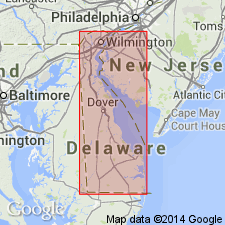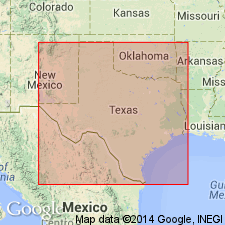
- Usage in publication:
-
- Trap subdivision
- Modifications:
-
- First used
- Dominant lithology:
-
- Sandstone
- AAPG geologic province:
-
- Permian basin
Summary:
Designated Trap subdivision as an informal unit within the upper part of the Bell Canyon formation of the Delaware Mountain group. Occurs in subsurface of the northern Delaware basin [in Permian basin], in northwest Reeves, Loving, and northeast Culberson Counties, Texas, and in southern Eddy and Lea Counties, New Mexico. Consists of thinly laminated, carbonaceous and (or) silty sandstone that ranges in thickness from 1 to 2 feet, up to 10 to 12 feet. Generally overlies the producing interval, Ramsey sand (new, informal), but where Ramsey is absent on paleostructural highs, overlies non-reservoir Ford siltstone (or subdivision) (new, informal), both of Bell Canyon formation. Underlies Lamar limestone member of Bell Canyon. Age is Permian (Guadalupian). Report includes stratigraphic chart and subsurface log correlations.
Type gamma ray-sonic log presented but not located. Origin of name not stated by author.
Source: Modified from GNU records (USGS DDS-6; Denver GNULEX).

- Usage in publication:
-
- Trap member
- Modifications:
-
- Revised
- Overview
- AAPG geologic province:
-
- Permian basin
Summary:
Redescribed from Trap subdivision (informal) to Trap member (informal). Is part of the upper Bell Canyon Formation of the Delaware Mountain Group, in Delaware basin area [in Permian basin], southwest Texas and southeast New Mexico. Is a thin unit (5 to 10 feet thick) and consists of interlaminated shaly siltstone and shale. Underlies Lamar Shale Member of Bell Canyon Formation and overlies Ramsey sandstone member (informal) of Bell Canyon, or locally overlies the Coyanosa limestone [local, unranked, informal unit]. Age is Permian (Guadalupian). Report includes stratigraphic chart and subsurface log correlations.
Source: Modified from GNU records (USGS DDS-6; Denver GNULEX).

- Usage in publication:
-
- Trap Member
- Modifications:
-
- Named
- AAPG geologic province:
-
- Permian basin
Summary:
Pg. 7-10. The Trap Member of the Bell Canyon Formation of the Delaware Mountain Group. The Trap Member, here [formally] named, is [in the informal "A" sand] in the upper Bell Canyon Formation of the Delaware Mountain Group in the central Delaware basin of Texas and New Mexico. Previously designated the informal Trap subdivision by Nottingham (1960) and the Trap member by Grauten (1965). This excellent and widespread regional nonproducing marker bed is restricted to a thin silt-sand marker below the base of the overlying Lamar Limestone Member of the Bell Canyon. Overlies the Ramsey Member [new, formal] of the Bell Canyon. [Age is Permian (Guadalupian).]
Type section (subsurface): Gulf J.R. Grandin No. 1 well, sonic-gamma ray log, SE/4 sec. 33, Blk. 29 PSL Survey, Loving Co., TX. Origin of name not stated by author.
Source: US geologic names lexicon (USGS Bull. 1565, p. 326-327).
For more information, please contact Nancy Stamm, Geologic Names Committee Secretary.
Asterisk (*) indicates published by U.S. Geological Survey authors.
"No current usage" (†) implies that a name has been abandoned or has fallen into disuse. Former usage and, if known, replacement name given in parentheses ( ).
Slash (/) indicates name conflicts with nomenclatural guidelines (CSN, 1933; ACSN, 1961, 1970; NACSN, 1983, 2005, 2021). May be explained within brackets ([ ]).

